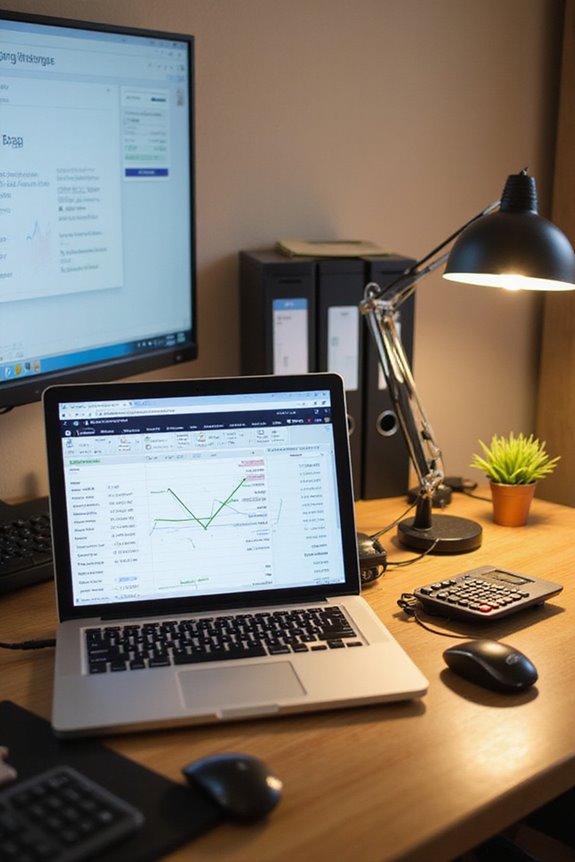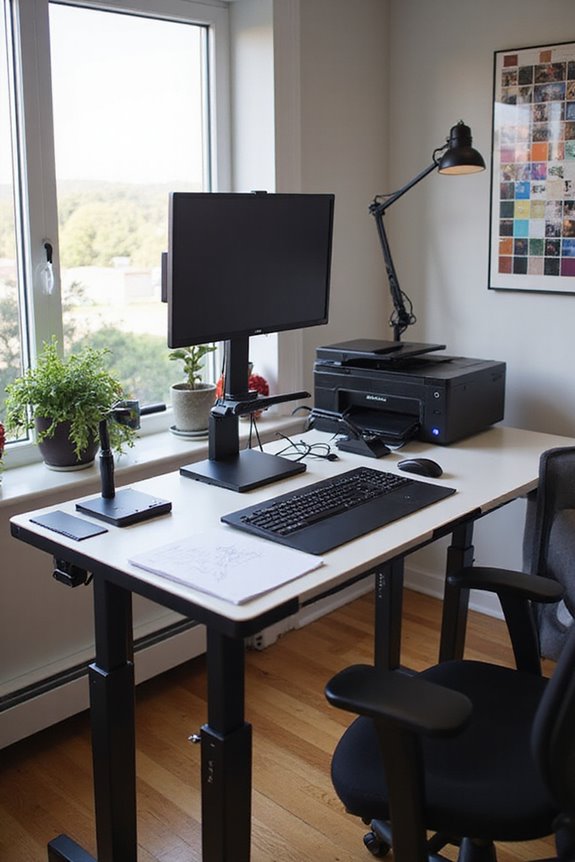To thrive in remote work, I find it’s essential to have high-quality laptops for performance, reliable internet routers for seamless connectivity, and comfortable headsets for clear communication. External monitors help boost productivity by allowing multitasking, while ergonomic chairs improve comfort during long hours. Additionally, using project management tools guarantees organized task management. Don’t overlook robust cybersecurity measures to protect sensitive information. If you want to discover more about optimizing your remote work setup, keep exploring further insights.
Key Takeaways
- High-quality laptops with advanced processors ensure flexibility and performance for effective remote work.
- Reliable internet routers provide seamless connectivity and security for smooth communication and data access.
- Comfortable headsets with noise cancellation enhance audio quality for clearer virtual meetings and calls.
- External monitors help boost productivity by facilitating multitasking and improving workspace organization.
- Cybersecurity measures, such as VPNs and multi-factor authentication, protect sensitive information while working remotely.
High-Quality Laptops for Flexibility and Performance
When it comes to remote work, having a high-quality laptop is essential for maintaining flexibility and performance. High performance laptops like the Apple MacBook Pro 14 and Microsoft Surface Laptop 7 offer advanced processors, ensuring smooth multitasking for demanding projects. The Dell XPS series also provides powerful Intel or AMD options, suitable for various professional workloads.
To create flexible workstations, consider features like touchscreen capabilities and robust battery life. The Microsoft Surface Laptop 7 boasts up to 20 hours of battery, while the MacBook Pro delivers over 18 hours, allowing for uninterrupted productivity. Investing in a high-quality laptop not only enhances your performance but also adapts to your diverse work needs, making remote tasks more manageable. Additionally, high-performance processors from Intel and AMD significantly improve overall efficiency during intense multitasking.
Reliable Internet Routers for Seamless Connectivity
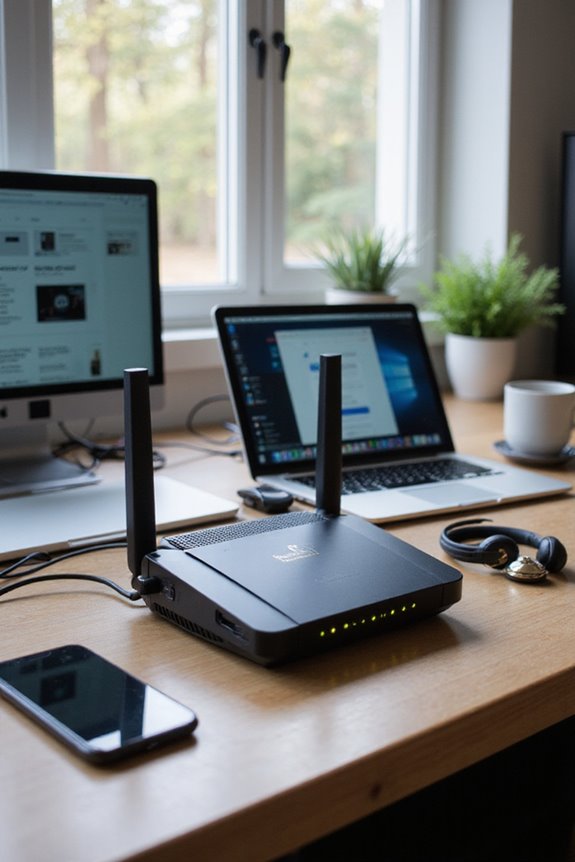
Reliable internet connectivity is a cornerstone of successful remote work, and having the right router can make all the difference. When selecting a router, I prioritize router performance and network security. For overall excellence, the Asus ROG Rapture GT-AX6000 stands out, while the Zyxel SCR 50AXE is perfect for business applications due to its multiple bands and security features. If you’re handling numerous devices, the Netgear RAXE500 offers robust performance. High-speed options like the TP-Link Deco XE75 mesh system guarantee extensive coverage in larger spaces. Additionally, strong security measures, such as built-in firewalls and VPN support, are essential to protect sensitive data. Investing in a reliable router can greatly enhance your remote work experience. Furthermore, routers with Wi-Fi 6 advantages provide faster speeds and improved efficiency, making them ideal for high-demand environments.
Comfortable Headsets for Enhanced Audio Quality

To guarantee effective communication during remote work, selecting a comfortable headset is essential. High-quality audio is critical for calls and meetings, and noise cancellation benefits can considerably reduce background distractions, ensuring clearer conversations. I’ve found that choosing a headset with a noise-canceling microphone enhances the clarity of my voice, making interactions more effective.
Additionally, the ergonomic design importance cannot be overstated. A headset that fits well and provides comfort allows me to work for extended periods without discomfort. This is essential for maintaining focus and productivity throughout the day. Overall, investing in a quality headset with these features can greatly improve your remote work experience, making communication smoother and more enjoyable. Furthermore, options like advanced noise cancellation technology can significantly enhance your audio experience in noisy environments.
External Monitors to Boost Productivity
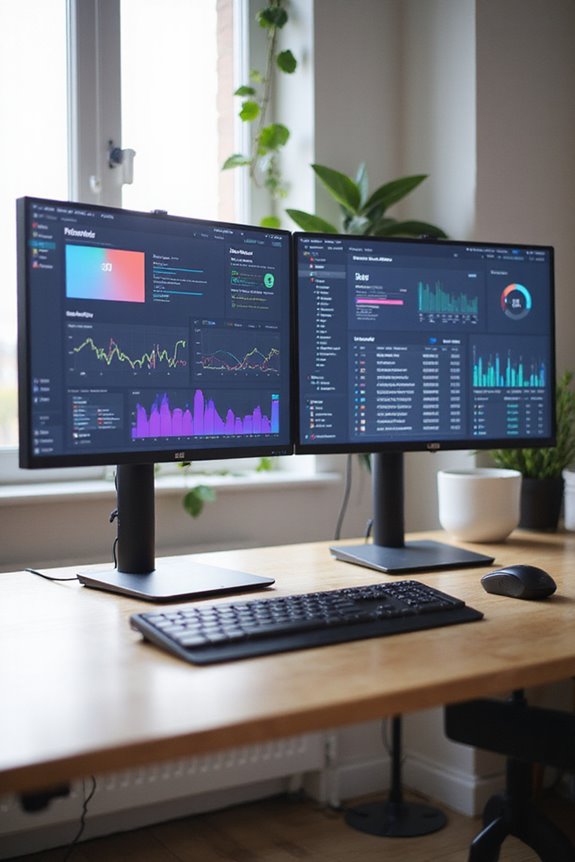
Having the right tools at your disposal can greatly enhance your remote work experience. One essential tool is an external monitor, or even better, a dual monitor setup. Studies show that using multiple monitors can improve productivity by 8–10% for light tasks and over 40% for complex workflows. With expanded screen real estate, I can efficiently run multiple applications side by side, reducing the need to constantly switch between windows. This improved workspace organization allows for easier data analysis, design work, or research. Additionally, having a second monitor keeps my emails and chats visible while I’m focused on primary tasks, ultimately enabling me to get more done in less time. Choosing a monitor with a 100Hz refresh rate can also enhance the overall experience, particularly for gaming and creative tasks.
Ergonomic Chairs for Improved Comfort

A well-designed ergonomic chair can make a significant difference in your remote work environment. These chairs offer essential ergonomic benefits like adjustable seat height and proper lumbar support, which help maintain ideal body posture. When I sit comfortably, I notice a marked productivity impact; improved posture keeps me alert and focused throughout the day.
Additionally, ergonomic chairs reduce the risk of musculoskeletal discomfort, allowing me to concentrate on tasks without frequent interruptions for pain relief. Investing in quality seating means I can work longer without feeling drained. Ultimately, a comfortable chair fosters a sense of value, motivating me to put forth my best effort and enhancing my overall remote work experience. Many ergonomic chairs incorporate adjustable lumbar support, which is crucial for reducing lower back discomfort during prolonged sitting.
Cloud Storage Services for Efficient Data Sharing

When managing remote work, using cloud storage services can greatly enhance your ability to share and collaborate on data. These platforms, like Google Drive and OneDrive, offer real-time collaboration features that streamline teamwork. With Google Drive’s integration with Docs and Sheets, or OneDrive’s compatibility with Microsoft Office, you can easily work together on projects.
Dropbox stands out for its robust file-sharing capabilities, making it ideal for collaborative efforts. Security is also vital; services like Tresorit provide zero-knowledge encryption for enhanced data protection. With a variety of free storage options available—Google Drive offers 15 GB, while Dropbox provides 2 GB—you can choose a service that fits your needs. Overall, cloud storage is essential for efficient data sharing in a remote work environment.
Project Management Tools for Task Organization

Effective collaboration in remote work settings requires not just data sharing but also well-organized task management. To enhance task efficiency, I recommend using popular project management tools like Asana, Trello, and Monday.com. These platforms help streamline workflows by allowing clear task assignments and deadline tracking.
- Asana offers robust features for automation and collaboration.
- Trello utilizes visual boards, making it easy to track tasks.
- Monday.com provides customizable workflows suitable for various team sizes.
They all support integration with tools like Slack and Google Drive, enhancing team collaboration. Free plans are available, so you can start improving your task management without a financial commitment. Choosing the right tool can greatly impact your productivity and project success.
Cybersecurity Measures to Protect Sensitive Information
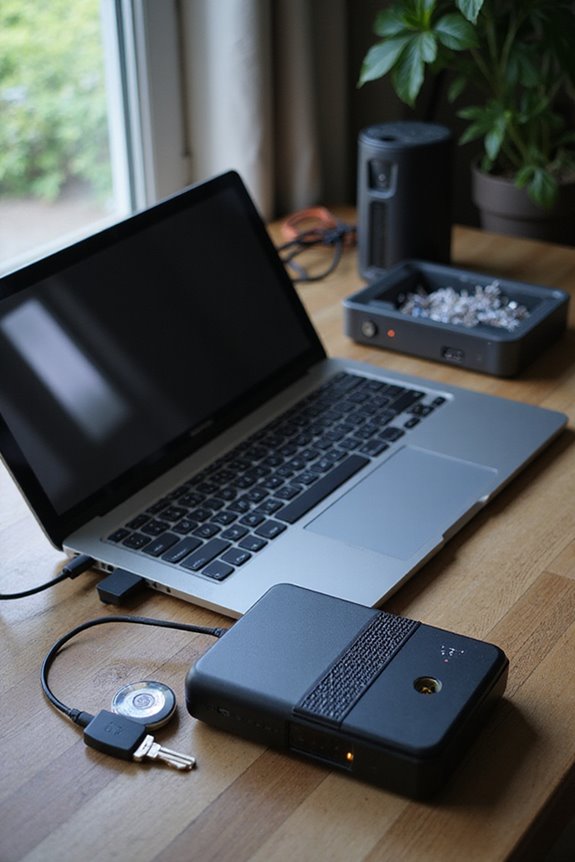
In today’s digital landscape, safeguarding sensitive information is more essential than ever, especially for those of us working remotely. To enhance cybersecurity awareness, I prioritize using organization-approved devices and secure Wi-Fi networks. This means avoiding personal or shared devices to minimize risks.
Implementing encryption practices is vital; I always use virtual private networks (VPNs) during remote connections to protect data in transit. Additionally, I enable multi-factor authentication (MFA) and maintain strong, unique passwords for all accounts. Regularly updating software and being aware of phishing scams further fortifies my defenses. Finally, I make sure to store work data strictly on designated work devices, ensuring sensitive information remains secure against unauthorized access.
Productivity and Wellness Tools for Balanced Work
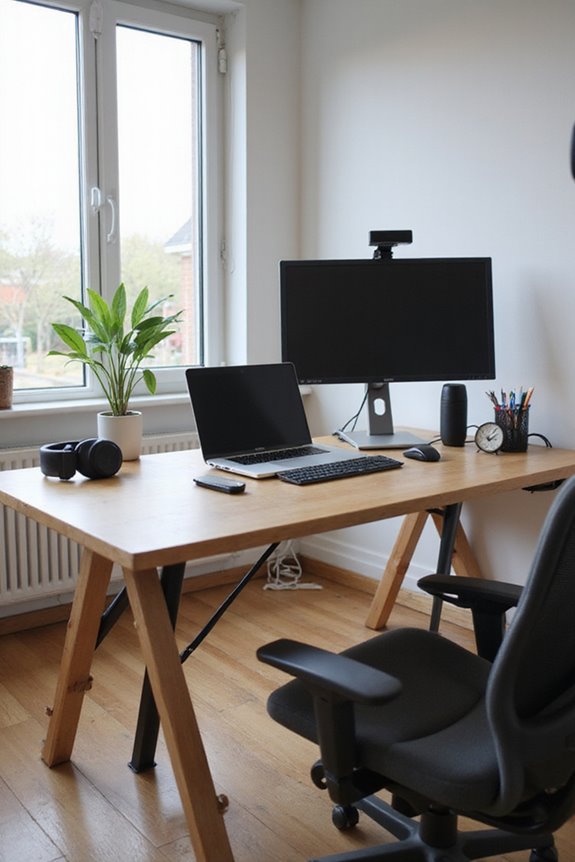
While working remotely can offer numerous advantages, it also presents unique challenges that require effective tools and strategies to maintain productivity and well-being. To enhance my work-life balance, I rely on a combination of productivity and wellness tools.
- Reliable High-Speed Internet guarantees smooth video calls and access to cloud resources.
- Project Management Software like Trello keeps my tasks organized.
- Scheduled Breaks are essential for mental health, allowing me to recharge.
- Physical Activity Tools, such as under-desk bikes, promote movement throughout the day.
- Mindfulness Apps assist in managing stress effectively.
Future Trends in Remote Work Technology
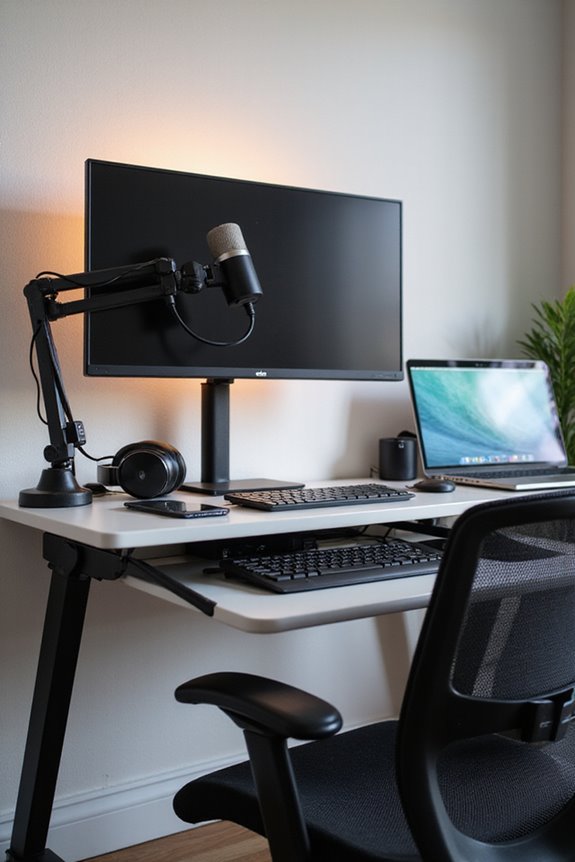
As remote work continues to evolve, it’s clear that emerging technologies will play a vital role in shaping the future of how we collaborate and operate. One significant trend is the integration of AI Collaboration, where artificial intelligence automates routine tasks, allowing teams to focus on strategic initiatives. This shift not only increases productivity but also enhances job satisfaction.
Additionally, Virtual Reality is gaining traction in remote environments, creating immersive experiences that mimic in-person interactions. As businesses adopt hybrid models, these technologies will facilitate seamless communication and foster a stronger team culture. By embracing these advancements, organizations can leverage global talent while catering to diverse work styles, ultimately transforming the remote work landscape for the better.
Frequently Asked Questions
What Is the Ideal Size for a Dedicated Workspace?
When considering workspace dimensions, I find around 10 square meters per person ideal. This allows for an ergonomic setup that promotes comfort and productivity, balancing personal space with areas for collaboration and creativity.
How Can I Reduce Distractions While Working Remotely?
Sometimes, it feels like I’m in a circus while working remotely! To reduce distractions, I use focus techniques like scheduling deep work sessions and effective noise management to drown out chaos, helping me stay productive and centered.
What Are the Benefits of Using a Standing Desk?
I’ve found that using a standing desk provides amazing ergonomic benefits and a significant productivity boost. I feel more energized, my posture improves, and I can focus better, making my workdays much more enjoyable and effective.
How Often Should I Take Breaks During Remote Work?
Like a well-timed sonnet, I find that taking short breaks every hour gives me a productivity boost. This break frequency clears my mind and keeps my creativity flowing while preventing burnout—essential for remote work success.
What Are the Best Practices for Maintaining Work-Life Balance?
To maintain work-life balance, I prioritize time management and boundary setting. I stick to specific work hours, create a dedicated workspace, and communicate my schedule to minimize interruptions, ensuring personal time remains protected and productive.


